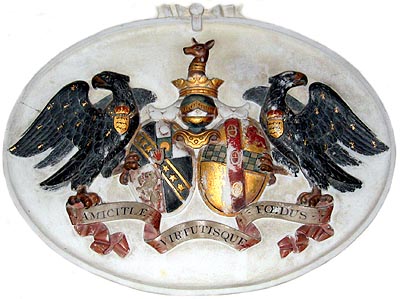 |
 |
|||
|
|
 Sir
John Coxe Hippisley Sir
John Coxe Hippisley(1747-1825) Born: 1747 at Bristol, Gloucestershire Political Writer Died: 3rd May 1825 at Mayfair, Middlesex John Coxe Hippisley, the political writer, was the only surviving son of William Hippisley of Yatton, Somerset (great great grandson of John Hippisley of the same place, who was recorder of Bristol in the reign of King Edward VI), by Anne, eldest daughter of Robert Webb of Cromhall, Gloucestershire. He matriculated at Hertford College, Oxford on 3rd February 1704, at the age of sixteen and was created DCL on 3rd July 1776. He was admitted as a student of the Inner Temple in 1766, was called to the bar in 1771 and became a bencher in 1803. During a residence in Italy in 1779 and 1780, Hippisley was engaged in confidential communication with the English Government. Early in the latter year, he married his first wife in Rome. Returning home in 1781, he was recommended by Lord North, First Lord of the Treasury, to the directors of the East India Company, from whom he received an appointment in India as paymaster at Tanjore in 1786, with the advanced rank of four years' service. In 1789, having held offices of trust and importance during the war with Hyder Ali and his son, Tippoo, he resigned and returned to England. From 1792 to 1796, Hippisley resided in Italy and was there again engaged in negotiations with the Vatican, the effects of which were acknowledged in flattering terms by the English Government. In 1796, he successfully negotiated the marriage of the reigning Duke of Wurtemberg with the Princess Royal of England. For this service, he was created a baronet on 30th April 1796. The Duke granted him the privilege of bearing the ducal arms, with the motto of the order of Wurtemberg, 'Amicitiae virtutisque foedus,' and the grant was confirmed by Royal sign-manual on 7th July 1797. Hippisley was appointed a commissioner and trustee of the Royal marriage settlement. The pecuniary distresses of the last survivor of the Stuarts, Henry Benedict, Cardinal York, were first brought to King George III's notice through letters addressed to Hippisley by Cardinal Borgia. Hippisley successfully pressed the cardinal's claims for relief. The cardinal bequeathed him several mementoes, now owned by a descendant. Hippisley became recorder of Sudbury and MP for the borough in 1790. At the general elections of 1796 and 1801, he was not returned to Parliament, but he was successful in 1802. He continued to represent Sudbury until 1819, when he finally retired from the House of Commons. He served, in 1800, as Sheriff of Berkshire, in which county Warfield Grove (now Warfield House), then his country seat, is situated; and, in the same year, he became one of the first managers of the Royal Institution of Great Britain. In 1811, when the Duke of Gloucester was installed as Chancellor at Cambridge, Hippisley received the honorary degree of MA as of Trinity College. In 1816, he was appointed treasurer of the Inner Temple. He was also a vice-president and steady supporter of the Literary Fund Society, one of the principal promoters of the literary institutions of Bath and Bristol, a member of the government committee of the Turkey Company and a vice-president of the West of England Agricultural Society. For many years, he was an active magistrate for Somerset. Hippisley died in Grosvenor Street, London on 3rd May 1825 and was buried in the Temple Church. He married, first, in 1780, Margaret, second daughter of Sir John Stuart, bart., of Allonbank, Berwickshire. She died in 1799. By her he had three daughters and one son, John, his successor. He married, secondly, on 18th February 1801, Elizabeth, daughter of Thomas Horner of Mells Park, and widow of Henry Hippisley-Coxe, MP for Somerset - who, if a relative, was very distant, despite the similarity in names. Another branch of the family were for many years lords of the manor of Lambourn Place. At this date they were represented by Rev. John Hippisley, third cousin and husband of Henry Hippisley-Coxe's sister, Margaret. By Elizabeth, John Coxe Hippisley became the owner of Ston Easton Park in Somerset, but had no issue. There is a monument with a long inscription to his memory in the parish church of Ston Easton. While a member of the House of Commons, Hippisley strenuously supported Roman Catholic emancipation and wrote in favour of the policy: 'Observations on the Roman Catholics of Ireland' (1806), 'Substance of Additional Observations, intended to have been delivered in the House of Commons, on the Petition of the Roman Catholics of Ireland' (1806), 'Substance of his Speech on seconding the motion of the Right Hon. Henry Grattan, to refer the Petition of the Roman Catholics of Ireland to a Committee of the House of Commons' (1810), 'Correspondence respecting the Catholic Question' and 'Letters to the Earl of Fingal on the Catholic Claims' (1813). He was also deeply interested in the treadmill question and published an octavo volume in 1823, recommending as a substitute the hand crank mill. Edited
from Sidney Lee's 'Dictionary of National Biography' (1891) |
|||
| © Nash Ford Publishing 2004 All Rights Reserved. | ||||



